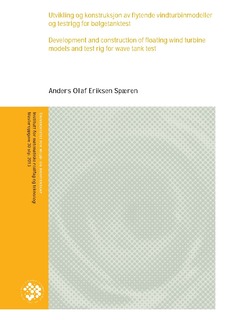| dc.description.abstract | Denne masteroppgaven er et ledd i utviklingen av det flytende vindturbinkonseptet "Tension Leg Buoy" og et simuleringsverktøy for flytende vindturbiner kjent som 3DFloat. Vindturbinkonseptet omfatter to ulike løsninger som vurderes mot hverandre. For å verifisere konseptene og 3DFloat ble det gjennomført en bølgetanktest i januar 2013. Arbeidet i denne masteroppgaven omfattet utvikling og ferdigstilling av vindturbinmodeller og annet utstyr som ble benyttet i denne testen. I tillegg ble det gjennomført en pretest for å se til at løsningene fungerte som planlagt.
Det ble først utført et forarbeid for å få et helhetlig bilde av problemstillingen som skulle løses. Krav og ønsker til konstruksjonene, samt tekniske rammer som ikke måtte overskrides, ble identifisert. Som en del av forarbeidet ble vindturbinkonseptenes dimensjoner og forventede belastninger nedskalert.
Hovedfokuset under utviklingen var å oppnå løsninger som ville gi effektiv tidsbruk og pålitelige resultater under bølgetanktesten. Det ble valgt å konstruere tre flytende vindturbinmodeller. To av disse ble utformet slik at de i størst mulig grad var i overensstemmelse med de to nedskalerte konseptene. Den tredje ble gitt en svært forenklet utforming for å gjøre verifiseringen av 3DFloat enklere, i form av mer forutsigbare dynamiske bevegelser.
Det ble utviklet et konsept for modellens forankringssystem som både kunne brukes i bølgetanken og i et basseng for pretest. Ankerpunktene ble utformet som trinser med den hensikt å kunne føre forankringslinene opp over vann. Der ble linene tilkoblet utstyr for justering og måling av lengden, stivheten og strekkraften. I bølgetanken ble trinsene festet til tårn som strakk seg fra overflaten og ned til riktig dybde. For å måle modellbevegelsene ble et 3D-kamerasystem benyttet som var tilgjengelig i bølgetanken.
Konstruksjonstegninger for komponenter ble tilvirket og sendt til valgte verksteder for produksjon. Videre ble det bestilt komponenter og utstyr som kunne kjøpes som standardvare. Modellene ble hovedsakelig produsert i aluminium av marin kvalitet. Enkelte av modellkomponenter måtte imidlertid produseres i plast, av tids- og kostnadshensyn.
Modellene og forankringssystemet ble testet i et basseng ved Universitetet for miljø- og biovitenskap. Det ble her kontrollert at forankringssystemet fungerte som tiltenkt og at modellene var vanntette.
Noen kompromisser måtte inngås underveis, men disse hadde ikke vesentlige negative innvirkninger på resultatet. Arbeidet med å montere modellene og justere forankringssystemet var enkelt og kunne gjennomføres effektivt. Trinsene måtte imidlertid byttes ut, som følge av stort friksjonsbidrag. Foreløpige analyser av testdataene og sammenligning med simuleringer indikerer at utstyret fungerte godt. Den endelige totalløsningen ansees derfor som svært god og tilfredsstillende. This thesis is a part in the development of the floating wind turbine concept tension leg buoy, and a simulation tool for floating wind turbines known as 3DFloat. The wind turbine concept comprises two solutions which are evaluated against each other. To verify the concepts and 3DFloat, a wave tank test was carried out in January of 2013. The work in this thesis covers the development and production of the wind turbine models and other equipment that was used in this test. In addition, a pre test was carried out to verify that the solutions would work as planned.
It was first conducted a preliminary research to get a complete picture of the problem that was going to be solved. Requirements and preferences associated with the structures were identified, in addition to the technical limitations which could not be exceeded. As part of the preparations, the dimensions and expected mooring loads for the wind turbine concepts where downscaled.
The main focus during the development process was to achieve solutions that would provide efficient use of time and reliable results during the wave tank test. It was chosen to construct three floating wind turbine models. Two of these were designed to be as consistent as possible with the two downscaled concepts. The third was given a very simplified design to make the verification of 3DFloat easier, with more predictable dynamic motions.
There was developed a concept of the mooring system for the models for use in both the wave tank and a pool during the pre test. The anchor points were designed as pulleys with the intention to guide the mooring lines up above the water level. Above water, the lines were connected to equipment for adjustment and measurement of length, stiffness and tension. In the wave tank, the pulleys were attached to three towers reaching from the surface down to the correct depth. To register the motion of the models, there were utilized a motion-capture system which was available in the wave tank facilities.
Engineering drawings for the components were made and sent to the selected workshops for production. Further, it was ordered components and equipment that could be delivered as a standard products. The models was mainly produced of an aluminum alloy with marine quality. However, some of the model components had to be produced in plastic, because of time and cost considerations.
The models and the mooring system was tested in a pool at the Norwegian University of Life Sciences. The functionality of the anchoring system were checked and the models were checked for leakages.
Some compromises had to be done in the development and production process, but these had no significant negative impact on the final result. Efforts to assemble the models and adjust the mooring system was easy and could be carried out effectively. The pulleys had to be replaced, due to a strong friction contribution. Preliminary analyses of the test data and comparison with simulations, indicate that the equipment worked well. The final solution is therefore regarded as very good and satisfying. | no_NO |

